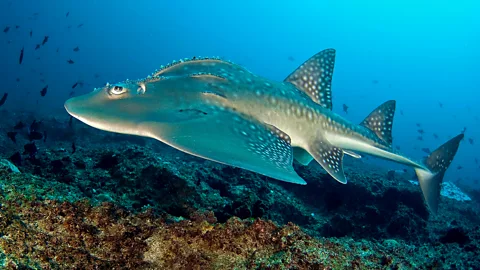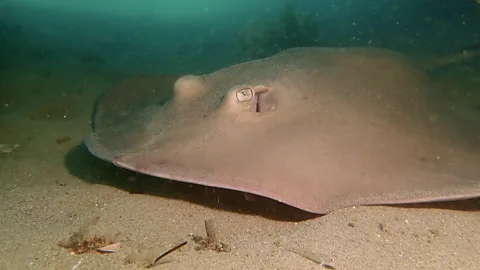Last year, the Java stingaree became the first fish to be declared extinct as a result of human actions. Could there soon be others?
In the bright coastal waters of Australia, Julia Constance has often sought out stingarees. These flat-bodied fish are like miniature stingrays but different. Stingarees are smaller – and more elusive. "They're super chill," says Constance, a PhD candidate at Charles Darwin University in Darwin, Australia. They don't swim alongside you like manta rays, she explains, as she recalls snorkelling expeditions that rewarded her with glimpses of the ghostly pale common stingaree.
"Once you get good," says Constance, "You can spot them when they're fully buried under the sand."
But there's one stingaree she probably won't ever see alive, skulking on the seabed. Last December, Constance and colleagues published an assessment of the mysterious Java stinagree, a species not documented by scientists for more than 160 years. It was extinct, Constance and her colleagues declared. And worse, the Java stingaree is the first marine fish considered to have gone extinct due to human activity.
This was a seismic bit of news, and not uncontroversial. "It is a really big call," says Constance. "It really ruffled quite a lot of feathers." The Java stingaree is one of those extremely enigmatic species that scientists know very little about. There is only one museum specimen in existence – bought by a German zoologist at a Jakarta fish market in 1862. How, some observers questioned, could we be sure that this really was a distinct species, and that humans were responsible for its disappearance?
That single specimen, held by the Natural History Museum in Berlin, is only 33cm (13in) long, including its tail. The colour of its skin has likely faded to what is now a pale brownish hue. It's a female but we don't actually know whether it is a juvenile or an adult, says Constance. To find out, one would have to cut it open and examine its reproductive organs. Since it is the only specimen, that won't be happening, she adds. But it is nonetheless noteworthy. "It is really, really round for a stingaree," says Constance, referring to the disc-like body of the animal.
It is so different from any other stingaree, and associated with an area not known to harbour other stingaree species, that we can be confident it is not a hybrid of some sort, Constance explains. Though she adds that she was only able to inspect the specimen from photos because her research took place at the height of the Covid-19 pandemic, which prevented her from travelling.
As for the judgement that the species is now extinct, and moreover that humans are to blame, Constance says she and her team relied largely on records of fishing industry activity from Indonesia. This included data from extensive surveys carried out at landing sites – places where fishers take their catch onto land, usually to sell it – in the country since 2001.
"There was this really, really big push to start documenting the catch of sharks and rays all through Indonesia," says Constance. "The Java stingaree would be really easy to identify if it was there."
 Alamy
AlamyBy entering all the information they could find about the stingaree into data analysis tools provided by the International Union for Conservation of Nature (IUCN), Constance and her colleagues found that the organisation's models were 93.5% confident that the Java stingaree had gone extinct. The IUCN, an international organisation that collects and provides information about the status of the world's species, published the results of the assessment on its website.
Diego Biston Vaz, senior curator of fish at London's Natural History Museum – who was not involved in the assessment – also cites the Indonesian survey data gathered since 2001 and says it "makes sense" that the IUCN was able to declare the fish officially extinct last year.
And yet, it remains startling to think that this is the first official marine fish extinction linked to human activity. Humans have caused the disappearance of at least 198 vertebrate species since 1900 – including various fish species found in rivers and lakes. But those species have more or less been confined to land or freshwater – ecosystems that tend to bear the brunt of our activities. In contrast, the planet's seas are vast and we have only just begun exploring the seabed in fine detail.
One possible reason that the Java stingaree is the only marine species to have been declared extinct is that marine habitats provide a much better chance for organisms to escape our influence by removing themselves to untouched areas, says Catherine Macdonald at the University of Miami Shark Research and Conservation Program.
"Even when we've very heavily influenced coastal environments, there are still parts of the ocean that are historically not that accessible to people," says Macdonald.
Macdonald adds that sharks and rays take a long time to reproduce. Close relatives of the Java stingaree might only produce offspring once or twice a year, at best, says Constance. That means any disruption to the species population from human impacts – such as fishing – could have a devastating effect.
Constance suggests that the Java stingaree was confined to a relatively small area subject to significant fishing activity. I ask whether it is possible that some disease or other natural event was, instead, responsible for the species' decline. "We can't say 100%" one way or another, she admits, though adds: "I think, overwhelmingly, it was us."
Not all declarations of extinction hold up, though. Constance mentions the case of the smooth handfish, from the coastal waters of Tasmania. It was actually the first fish declared extinct in modern times, in 2018. However, a reassessment in 2021 determined that the data used to back up this declaration was insufficient. The IUCN subsequently relisted the status of the fish as "unknown".
We should maintain a very high bar for concluding that a species has gone extinct, stresses Riley Pollom, species recovery programme manager at the Seattle Aquarium, because the moment it is considered gone, all conservation efforts stop. If you erroneously declare a species extinct, and measures to protect it evaporate, then – ironically – it might really go extinct as a result of this change in status.
Pollom and Macdonald note that there are multiple shark, ray and skate species around the world currently threatened with extinction, including the Maugean skate in Tasmania; the broad-bodied bowmouth guitarfish of Asia, northern Australia and eastern Africa; and the Indo-Pacific leopard shark.
And while scientists can be fairly confident about the extinction of the Java stingaree, says Pollom, he points out that the sheer scale of the world's oceans means that experts may have missed other extinctions tied to human behaviour. "Basically, there could be a lot slipping past us without us knowing," he says. (Read more from BBC Future about the unknown species in the deep ocean.)
 Getty Images
Getty ImagesConstance's search for the Java stingaree is far from over. For one thing, she keeps an eye on museum collections just in case another historical specimen ever turns up. A separate species she has studied lately, a critically endangered type of ray called the Red Sea torpedo, has been preserved in museums – but there are only three known specimens and, for years, one of them had been missing. A curator informed her just last year that they had found it again, she says.
Plus, this summer Constance was finally able to travel to Jakarta herself to observe operations at two major fish landing sites there, having not previously been able to do so during her research, due to Covid-19 restrictions. She and her colleagues scoured the piles of freshly caught fish for shark and ray species. And she couldn't help but wonder whether she might spot a Java stingaree among the horde.
"It's always in the back of my mind – what happens if someone finds it?" says Constance. But, despite the gravity of her and her colleague's declaration in 2023, she wouldn't be upset or disappointed if the extinction turned out to be a mistake.
"We want these things to be surviving into the future," says Constance. "It would be so cool if somebody were to find it someday."
--
For more technology news and insights, sign up to our Tech Decoded newsletter, while The Essential List delivers a handpicked selection of features and insights to your inbox twice a week.


Post a Comment